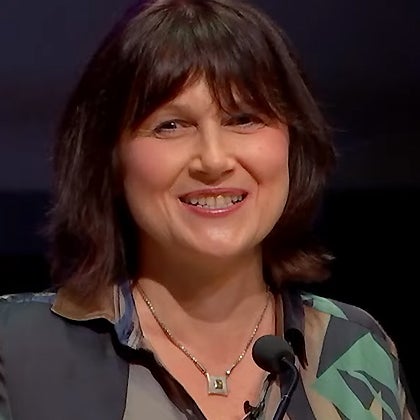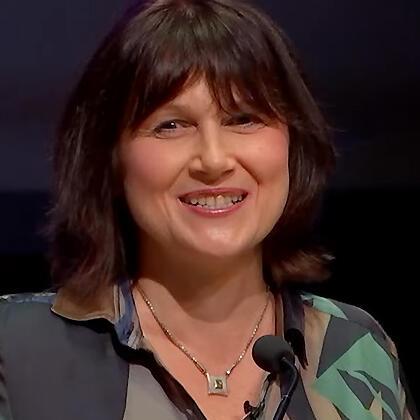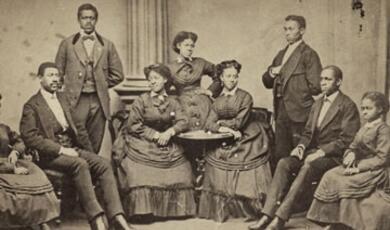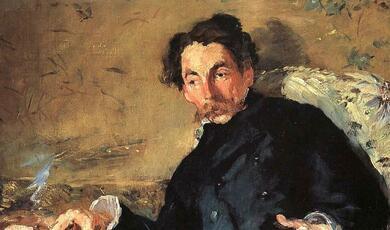Shostakovich on Trial: from Lady Macbeth to the Fifth Symphony
Share
- Details
- Transcript
- Audio
- Downloads
- Extra Reading
This lecture will focus on one of the watershed moments of Soviet music history: the censure of Shostakovich’s opera Lady Macbeth of Mtsensk, and the composer’s path through reform to rehabilitation. The Shostakovich story was only the tip of the iceberg, and almost all Soviet composers had to adjust their aesthetic and style at this point, unless they were prepared to languish in obscurity and poverty.
Download Transcript
In this lecture we will examine one of the most notorious events in the history of Soviet music: the so-called Lady Macbeth scandal. The outlines of the story are well known: Stalin went to see the opera, the opera was denounced in Pravda two days later, and then banned, after which Shostakovich withdrew his Fourth Symphony before it could be performed and wrote his Fifth in a very different style. The Fifth won high praise and proved that Shostakovich was a “reformed” artist who could be accepted back into official favour. The story is usually given one of two interpretations: Did Stalin win the day? Or did Shostakovich trick the regime by subtly placing evidence of his opposition in the Symphony?
There is nothing essentially wrong with this outline, but today, we will flesh it out with some intriguing and lesser-known details and place it within the broader context of the arts and life in 1930s’ Russia.
Lady Macbeth of Mtsensk
Shostakovich’s opera was premiered in January 1934 under two different titles: Lady Macbeth of Mtsensk in Leningrad and Katerina Izmailova in Moscow. The opera reinterprets a story by the 19th-century writer Leskov, and the first title is taken from this, rather than from Shakespeare; the second title is simply the name of the protagonist. The number of performances at all venues during the first two years came to a total of more than two hundred, so the piece enjoyed a remarkable degree of success. 1935 saw international productions in Cleveland, Philadelphia, Zürich, Buenos Aires, New York, London, Prague, Stockholm. In December 1935, it finally came to Moscow’s Bolshoi Theatre (second stage), and this is what prompted Stalin to attend, since this was the only theatre where he went to see opera or ballet productions. So on 26 January, Stalin was in his box at the Bolshoi, and Shostakovich was called urgently to the theatre, in the expectation that he would be given an audience with Stalin after the performance. Stalin had done exactly this a couple of weeks earlier, when he spoke to the younger composer Ivan Dzerzhinsky, after a performance of his opera Quiet Flows the Don. But this time, things turned out very differently: Stalin left the theatre in the interval before the final act, plunging Shostakovich into confusion and fear. On 28 January, an unsigned editorial in Pravda poured derision on the opera.
(See Appendix I for the translation of the complete article)
I will not go into great detail on the opera itself today, since I have already covered it in one of my previous Gresham lectures, which you can find here: https://www.gresham.ac.uk/lectures-and-events/shostakovich-lady-macbeth-mtsensk
Today, instead, we will focus our attention on the reasons for Stalin’s disapproval, and then on the consequences.
What did Stalin so dislike about the opera? After all, it had already won sufficient official approval to run for two years and to be performed abroad. Foremost was probably the notorious sex scene: no matter how restrained the staging may be, Shostakovich’s music is hilariously – or obscenely – graphic. Stalin was by then presenting himself as a figure of great dignity, and his presence at such a display undermined this image. It is also likely that he would have been disturbed by the general musical hooliganism of the score, which threw challengingly dissonant music alongside raucous parodies of popular genres. Given all of this, the sheer loudness of the orchestra, which included an extra brass section, would have made matters worse. Stalin decided that the opera had to go. He would not, of course, have published his private opinions, but he wanted a hit piece written in suitable ideological terms, and the task was entrusted to the Pravda journalist David Zaslavsky (whose identity was unknown until recently).
The Campaign Against Formalism
This was unprecedented. No composer, and indeed no artistic figure of any description had been personally attacked in Pravda, the regime’s most authoritative mouthpiece. There was even a follow-up article that castigated Shostakovich’s ballet The Limpid Stream. Shostakovich had finally become a household name across the Soviet Union, even among those had never heard a note of his music. The Union of Soviet Composers had to hold discussions on the Pravda articles, and Shostakovich’s colleagues were divided: some resented him in any case, some reluctantly conformed, and only a few took the risk of showing any solidarity.
There was a third article in Pravda, although this actually took the spotlight off Shostakovich, by broadening the criticism to all working in the arts. Following this, each of the arts was slapped down in articles such as “Cacophony in Architecture”, “On Painters-Daubers”, “Cinematic Bunglers”, “Hackwork in Film Music”. Artists had to rally to the cause of Socialist Realism. Down with Formalism! There were meetings where artists carried out rituals of self-abasement and condemnation of others.
What is “Formalism” Anyway?
As a Soviet term of opprobrium, the word had been in use since Trotsky’s 1923 critique of the “formalist” school of literary theorists (Shklovsky) and their belief in the primacy of form in art. Trotsky, then, applied the term “formalism” to the work of certain art theorists and critics, while the art that they favoured he called “futurism”. Over the next few years, “futurism” largely dropped out of the discourse, and “formalism” was applied directly to artworks. It would do little harm to think of “formalism” as simply the Soviet word for what we call “modernism” (although there are a few circumstances where they are not interchangeable). In the years around 1930, “formalism” was heard most often in the world of the visual arts, but music gradually came within its scope, as in the criticisms of Gavriil Popov’s Symphony in 1935 (a piece comparable to the Fourth Symphony that Shostakovich withdrew the following year). In the wake of the Lady Macbeth scandal, the philosopher Valentin Asmus was commissioned to write a scholarly exposition of formalism. His writing is highly convoluted but the following substantial points can be drawn from it:
- Artists should convey their message through expressive means that combine the “old” with the “new”, as in language.
- The form of an artwork is the outcome of the artist’s struggle to express the content as well as possible; form is not the leading principle.
- Artists shows mastery when the form is such a perfect expression of the content that it is transparent to the readership or audience.
- Innovation may be a by-product of an artist’s work, but it cannot be the goal; the appreciation of form is not separable from the appreciation of content
- Formalist artists and theorists wrongly believe that the struggle between tradition and invention plays out within an autonomous artworld.
- Correctly understood, this struggle is only part of the broader social and political struggle: artists will participate in history and in the class struggle to a greater or lesser degree, and this will determine the conviction and passion of their artistic work.
In Soviet art theory, then, “formalism” not a free artistic choice, but the result of ideological error: artists whose work is formalist are not committed to the building of socialism, but instead express bourgeois ideology, whether they know it or not. This was already implicit in the criticisms of Shostakovich during the Lady Macbeth scandal, and it would resurface in future criticism he received (above all, in 1948).
The Fourth Symphony and the Climate of 1936
Shostakovich wrote the first two movements of the Fourth before the Lady Macbeth scandal, but continued work on third and final movement during the most acute phase of the crisis, when his supporters were very thin on the ground, his music was not being performed at all, and he was facing impoverishment. The Symphony is a steep challenge for performers and listeners alike: it is well over an hour long, written for a huge orchestra, and the structure of the outer movements is difficult to grasp. The first movement, for example, contains a series of huge climaxes, often intensified by extreme dissonance. The finale eventually seems to be heading towards triumph and glory, but the expectations are raised only to be frustrated, and the symphony fades away mournfully for several minutes.
When Shostakovich went to see the Chairman of the Committee for Arts Affairs Kerzhentsev on 7 February 1936, he was told that a letter of contrition was not to the point – his response, rather, should appear in his music. This meant, in effect, that the Fourth Symphony, which was soon to be completed, would be seen as his definitive response to the official criticisms. In the Pravda articles, the critic Sollertinsky, who was a friend of Shostakovich, had been singled out as a bad influence on the composer. Now, acting as a spokesman, he promised that Shostakovich would deliver “a Soviet musical tragedy – a Soviet heroic symphony”. The symphony he referred to was the Fourth, with which he was already familiar.
Once he had emerged from his intense work on the Finale, Shostakovich had to consider the practical prospects. If the Fourth was his response to criticism, then it would not be understood as an attempt at reform, but much more likely as a bold gesture of defiance. He had seen the denunciations of many other prominent artists, like the novelist and playwright Mikhail Bulgakov. The leading theatre director, Meyerhold, was even required to explain how he would combat “Meyerholdism”. After the first major show trial, in August 1936, of former revolutionaries who were now “enemies of the people”, the wave of arrests spread to the social circles of the condemned men, including artistic and other intellectual figures. Among the arrested was the husband of Shostakovich’s sister Maria.
A letter from Shostakovich’s professor Maximilian Steinberg makes the composer’s difficulties plain:
“I found out from Mitya [Shostakovich] about the trial of the chief accountant and the cashier at the Vseroskomdram [the artists’ rights agency], who stole 250 thousand roubles and have been sentenced to death. It is awful to hear this about the people you’ve dealt with so many times without ever suspecting anything like this. Mitya is in great doubt about the forthcoming performance of his 4th symphony. …. [it] was written before the Pravda articles and is obviously a vivid example of the “chaos”. [Steinberg is referring to the title of the Pravda article, “Chaos instead of Music”].”
But Shostakovich was mesmerised, and the countdown to disaster continued. Rehearsals began in December 1936. It was only several days into the rehearsals when Shostakovich received advice from the Philharmonia director and also from some visiting party officials that he should withdraw the work. Shostakovich finally reconciled himself to the fact that the Symphony should not be performed at any time in the foreseeable future (it actually had to wait until 1961).
The Fifth Symphony
Anyone hearing the Fifth Symphony after the Fourth moves into a different musical world, although the composer is still recognisable. The Fifth is more classical in shape and it advertises its reliance on the officially encouraged models, particularly Beethoven and Tchaikovsky, instead of his bad old models of Mahler, Hindemith, or Krenek (although they are still there, lurking in the shadows). The Fifth also lends itself to interpretation in narrative terms, especially the Beethovenian pattern of passing through struggle to victory. Among today’s Shostakovich scholars, there is a strong current arguing that Shostakovich would have arrived at a more lucid and classical style even without external pressures, since some of his recent work had displayed these characteristics, such as the Cello Sonata of 1934. Perhaps, or perhaps the Cello Sonata might have proved an outlier, since the Fourth suggest a very different direction. But this approach is stubbornly unhistorical in any case, since the decisive change in his style, when it came, was induced through fear of a ruined career and even fear for his life. These pressures were absent for composers in the West who moved in a more conservative direction in the 30s (while others persisted with more difficult modernist idioms).
Looking at the chronology around the birth of the Fifth, we cannot fail to see how close the wave of arrests came to Shostakovich.
Perhaps Shostakovich escaped arrest by lucky chance, or perhaps he was by that stage already protected. One project that might have worked as a shield was a film score for the film “The Great Citizen”. The film, based on the assassination of Kirov, was conceived as a justification for the Purges and Stalin himself had a hand in the scenario. Shostakovich wrote the music immediately after the completion of the Fifth Symphony, and the heroic fanfare of the finale migrated to the title sequence of the film as a theme of the victory of socialism. Perhaps this connection also worked retroactively as an insurance policy for the symphony, since the final peroration would be seen as impeccably Soviet, rather than riven by ambiguity.
The premiere of the Symphony in Leningrad received a standing ovation, which had as much to do with the support of Shostakovich as it had with the music. More generally speaking, the public and critical reaction was varied. Even though the relentless harshness of the Fourth is gone, the score is complex, and on a first hearing, audiences struggled to make sense of the Symphony. The astonishing slow movement seemed to make the deepest impression, as a kind of requiem. The heroic, major-key ending was found less pleasing. Some thought it was an insincere formality; others found its incessant repetition of the same note troublesome – a kind of hammering or battering. One listener even came close to imagining the composer receiving a reprimand: “the music is very powerful, with tender motifs and then, suddenly, with terrible march-like thunderings. It seems to me that this is how the objective [world] bangs on the door of his study when he is sitting oblivious, indulging in “abstractions”.[1] Whatever the details, listeners were able to receive the symphony as a reflection of the terrible events they were living through, which they could not even discuss with close friends, and they could also discern an autobiographical narrative. The critics, after some shuffling of feet, came round to the consensus that that Shostakovich had either undergone his reform successfully, or was at least poised on the threshold of reform. Shostakovich won this round.
The Symphony’s autobiographical possibilities have recently been taken in an unexpected new direction. It turns out that the Symphony is peppered with quotations from Bizet’s opera Carmen. These references, moreover, were not just a musical game, but had a personal significance, linking the symphony beyond all doubt to Elena (Lala) Konstantinovskaya, with whom he had an affair (serious enough for him to divorce his wife, although he remarried her in the end). After the affair ended, he did not forget her. When she was arrested in 1936, he took the risk of contacting her to raise her morale. He would have followed her progress after her release, when she enlisted to be sent to revolutionary Spain (she was an interpreter), and there married the celebrity documentary film-maker Roman Carmen. It is she, Lala Carmen, who inspired the Symphony’s secret subtext, and the 250-odd repetitions of the note A (la) in the coda of the finale, which people heard as battering and hammering, can be explained more concretely as an obsessive repetition of the name Lala (whether genuine obsession or self-deprecating humour, we cannot know).
This private dimension of what used to be considered a “civic” statement sets up a new challenge for scholars, critics and listeners alike. But even if the Symphony is regarded as mainly personal in character, this doesn’t necessarily remove the work from history. When we read the diaries of the few who dared to keep them in this period, we find not only the expected talk of perpetual fear, silence and grief, but also about the coping strategies. The diarists write about their intense desire to live in the moment, to live and love knowing each day might be their last. And although Shostakovich himself did not keep a diary, other artists surely spoke for him when they said that their intense artistic work became a blissful escape. Writing the Fifth Symphony was for him, we can now imagine, an immersion into work at the highest level of inspiration and at the same time a reliving of the all-consuming Lala story. In 1937, a composer of textless music could lay much more before the public than a writer who was tied to words.
More Private Messages
The Six Romances on Verses by English Poets is another deeply personal work. It was composed in 1942 and published the following year, when the wartime censors were too busy to attend to such minor nuisances as song cycles. In 1948, with a resurgence of anti-formalist campaigning, the work was banned, although this was rescinded in 1949. Although the songs are ostensibly just settings of classic verses in new translations, each one is dedicated to an intimate friend of Shostakovich, and given the composer’s known habits, we can expect various messages both in the choice of text for each dedicatee, and also in the details of the music. Sir Walter Raleigh’s poem, for example, was a warning to the poet’s son, telling him that he was too much of a “wag” for his own good, and that his behaviour might in the end lead him to the gallows. The dedicatee Levon Atovmyan, an important figure in music administration, had already been arrested in the late 1930s but manage to escape the worst. Moreover, Atovmyan’s memoirs very much point to the description “wag” being very appropriate. The key of “his” song (A, or La) is likely to refer to his initials.
Sir Walter Raleigh to His Sonne
“Three things there be that prosper up apace
And flourish, whilst they grow asunder far,
But on a day, they meet all in one place,
And when they meet, they one another mar;
And they be these: the wood, the weed, the wag.
The wood is that which makes the gallow tree;
The weed is that which strings the hangman's bag;
The wag, my pretty knave, betokeneth thee.
Mark well, dear boy, whilst these assemble not,
Green springs the tree, hemp grows, the wag is wild,
But when they meet, it makes the timber rot,
It frets the halter, and it chokes the child.
Then bless thee, and beware, and let us pray
We part not with thee at this meeting day.”
Most of the texts are dark and reflect the climate of oppression and fear during the Purges. The most outspoken in this context is Shakespeare’s Sonnet 66:
“Tir'd with all these, for restful death I cry,
As, to behold desert a beggar born,
And needy nothing trimm'd in jollity,
And purest faith unhappily forsworn,
And gilded honour shamefully misplac'd,
And maiden virtue rudely strumpeted,
And right perfection wrongfully disgrac'd,
And strength by limping sway disabled,
And art made tongue-tied by authority,
And folly, doctor-like, controlling skill,
And simple truth miscall'd simplicity,
And captive good attending captain ill.
Tir'd with all these, from these would I be gone,
Save that, to die, I leave my love alone.”
The translation was by Pasternak, who changed “love”, in the last line, to “friend”, and Shostakovich dedicates the song to his most cherished friend of all, the musicologist Ivan Sollertinsky (mentioned earlier). Sollertinsky was the composer’s mentor as well as his confidant and was known as such after the Pravda article named him as a source of Shostakovich’s musical delinquency. This setting is particularly unusual and seems to be full of potential ciphers. Sollertinsky was a polymath and a specialist on early music, so perhaps this riddle in a “learned” style was meant to entertain him. We do not have the key to the riddle, but we can make a few observations nonetheless.
None of the vocal phrases return to the same melody or the rhythm, but they are based on various permutations of smaller melodic and rhythmic units. There is also a numerological game in play: Sonnet 66 is to be sung in the tempo of 66 beats per minute. The first vocal phrase contains two intervals of a sixth. There is also a motif in the piano that appears six times. The sonnet divides into rhymed units of 4+4+4+2 lines, but the music divides the poem into 7+7, which breaks down further as 4+3+3+4, while the number of bars in the song is 77. The number of differently spelled pitches in the melody is 13 = 6+7 (the normal twelve notes plus a re-spelling of B as C-flat). Sollertinsky’s surname in the Russian spelling “Соллертинский” also contains 13 letters. There may well be several more such amusing patterns to be discovered.
The first syllable of Sollertinsky’s name, sol, is the same as the note G, which features in the main key of G major and also in the constant repetitions of the note G in the bass. The note B is also given special prominence in the opening bars, also known as the note si, while Sollertinsky’s initials are the reverse, I.S. The D that would have completed the principal triad is notably lacking, so the opening bars are not simply what we would expect of any piece in G major. Just before the last line (“save that, to die, I leave my friend alone”), the D appears prominently in the bass, and in bar 67 we have the E-flat on top of it (called “Es” in German), which Shostakovich used to represent the letter S in other musical cyphers. I suggest that D and “S” represent Dmitry Shostakovich, who joins his friend in the last few bars.
(See Appendix II for the original poem texts; note that Shostakovich set their Russian translations which are sometimes quite free)
© Professor Frolova-Walker 2022
References and Further Reading
Marina Frolova-Walker and Jonathan Walker, Shostakovich. Symphony No. 5 (Oxford Keynotes), forthcoming in 2022
V. Asmus, “Teoreticheskiye korni formalizma”, Sovetskoye iskusstvo (17 March 1936), 2.
A. Benditskiĭ, O Pyatoĭ simfonii D. Shostakovicha (Nizhny Novgorod: Nizhegorodskaia gosudarstvennaia konservatoriia im. M.I. Glinki, 2000).
Manashir Iakubov’s commentary in Dmitry Shostakovich, New Collected Works, Vol. 5.
Richard Taruskin, “Public Lies and Unspeakable Truth: Interpreting the Fifth Symphony”, in Defining Russia Musically: Historical and Hermeneutical Essays (Princeton, NJ: Princeton University Press, 1997), 511-544.
Appendix I
This is Chaos, not Music: On the opera Lady Macbeth of Mtsensk District
(Pravda, 28 January 1936)
Transl. by Jonathan Walker and Marina Frolova-Walker
“As the general cultural development of our country has progressed, so the need for more good music has grown. At no other time, and in no other place have composers been faced with such a grateful audience. The masses of the people are waiting for good songs – and equally for good instrumental works and good operas.
At various theatres today, this new, culturally educated Soviet public is presented with Shostakovich’s opera, Lady Macbeth of the Mtsensk District. The theatres offer it as a novelty, as some sort of achievement. Servile music critics praise the opera to the skies, trying to manufacture a resounding success for the work. Although serious and substantive criticism could have aided the young composer in his future work, instead all he hears are fulsome compliments.
From the opera’s first moments, the astonished listener is assaulted by a stream of sounds that is – by design – inharmonious and chaotic. Snatches of melody and embryonic musical phrases are drowned, surface a final time, then finally disappear back into the general din of screeching and screaming. Such music is hard to follow and quite impossible to memorize.
And so it goes on almost throughout the opera. Singing is replaced by shouting. If once in a while the composer accidentally stumbles upon a simple, comprehensible melody, then immediately, as if frightened by the prospect, he throws himself into dense thickets of musical chaos, at times the purest cacophony. The expressivity needed by the listener is replaced by rabid rhythms. The expression of passion is left to musical noise.
Yet none of this results from any lack of talent on the part of the composer, nor from any inability to express simple and strong feelings through music. Instead, this is music that has deliberately been constructed in a jumbled manner, so that there is nothing to remind us of classical opera, symphonic sonorities, or simple, accessible musical speech. The music is based on the negation of opera – on the same principle generally used by leftist art to negate simplicity, realism, comprehensibility, or the natural sound of speech in the theatre. This is the transplantation of “Meyerholdism” into opera and music, but multiplied many times over. This is leftist chaos, not natural human music. The ability of good music to grip the masses is sacrificed to petit-bourgeois formalism, which pretends to be original while merely indulging in cheap playacting. This is a game of unintelligibility that can end in tears.
The dangers of this trend in Soviet opera are very clear. These foolish leftist deformities in opera stem from the same source as leftist deformities in painting, poetry, pedagogy and science. Petit-bourgeois “innovation” would cut us off from true art, true science or true literature.
The composer of Lady Macbeth had to borrow the neurotic, convulsive, epileptic music of jazz in order to provide some his characters with “passion”.
At a time when the touchstone of our criticism is socialist realism – and this certainly includes music criticism – Shostakovich’s opera puts the coarsest naturalism on stage. Monotonously, all characters are presented in their most bestial colours – merchants and people alike. The predatory merchant’s wife, whose path to money and power was paved with the corpses of her victims, is here presented as somehow a “victim” of bourgeois society. Leskov’s novel of everyday life [on which the opera is based] is here encumbered with meanings wholly absent from the original.
And how coarse, primitive and vulgar all of this is! The music wheezes, groans, pants, and gasps for breath in order to present love scenes as naturalistically as possible. And “love” is smeared all over the opera in the most vulgar manner. The merchants’ double bed is placed centre stage. And it is on this bed that all the “problems” are solved. Flogging and death by poison are presented in this same coarsely naturalistic style.
The composer probably never set about the task of listening to the demands of Soviet audiences. It is as if he deliberately encoded his music, jumbling all the sounds so that it would be accessible only to formalist aesthetes devoid of all healthy tastes. He has ignored the demand of Soviet culture – that we remove coarseness and savagery from every corner of Soviet life. This paean to merchants’ lust is dubbed a satire by some critics. But there is no trace of satire here. Using every means of musical and dramatic expression at his disposal, the composer is trying to win over the public’s sympathies to the coarse and vulgar deeds and desires of the merchant’s wife, Katerina Izmailova.
Lady Macbeth has enjoyed considerable success with the bourgeois public abroad. But isn’t this because this opera is chaotic and apolitical? Isn’t it because the opera’s twitching, clamorous, neurotic music titillates the perverted tastes of bourgeois audiences?
Our theatres have put a lot of effort into a conscientious production of Shostakovich’s opera. Actors have revealed significant talent in overcoming the noise, clamour and screeching that emanates from the orchestra. They use their acting powers in an attempt to compensate for the opera’s melodic poverty. Alas, this has only thrown the opera’s coarse naturalism into relief. Talented acting deserves recognition, but their wasted efforts are only to be pitied.”
Appendix II
1. Sir Walter Raleigh to His Sonne
Three things there be that prosper up apace
And flourish, whilst they grow asunder far,
But on a day, they meet all in one place,
And when they meet, they one another mar;
And they be these: the wood, the weed, the wag.
The wood is that which makes the gallow tree;
The weed is that which strings the hangman's bag;
The wag, my pretty knave, betokeneth thee.
Mark well, dear boy, whilst these assemble not,
Green springs the tree, hemp grows, the wag is wild,
But when they meet, it makes the timber rot,
It frets the halter, and it chokes the child.
Then bless thee, and beware, and let us pray
We part not with thee at this meeting day.
2. Robert Burns
Oh wert thou in the cauld blast,
On yonder lea, on yonder lea;
My plaidie to the angry airt,
I’d shelter thee, I’d shelter thee:
Or did Misfortune’s bitter storms
Around thee blaw, around thee blaw,
Thy bield should be my bosom,
To share it a’, to share it a’.
Or were I in the wildest waste,
Sae black and bare, sae black and bare,
The desert were a Paradise,
If thou wert there, if thou wert there.
Or were I monarch o’ the globe,
Wi’ thee to reign, wi’ thee to reign;
The brightest jewel in my crown
Wad be my queen, wad be my queen.
3. Robert Burns - MacPherson’s Farewell
Farewell, ye dungeons dark and strong, The wretch's destinie! Macpherson's time will not be long On yonder gallows-tree. Sae rantingly, sae wantonly, Sae dauntingly gaed he; He play'd a spring, and danc'd it round, Below the gallows-tree
Oh, what is death but parting breath? On many a bloody plain I've dar'd his face, and in this place I scorn him yet again.
Untie these bands from off my hands, And bring to me my sword; And there's no a man in all Scotland, But I'll brave him at a word.
I've liv'd a life of sturt and strife; I die by treacherie: It burns my heart I must depart, And not avenged be.
Now farewell light--thou sunshine bright, And all beneath the sky! May coward shame distain his name, The wretch that dares not die! Sae rantingly, sae wantonly, Sae dauntingly gaed he; He play'd a spring, and danc'd it round, Below the gallows-tree.
4. Robert Burns
O, Jenny's a' weet, poor body,
Jenny's seldom dry:
She draigl't a' her petticoatie,
Comin thro' the rye!
Chorus
Comin thro' the rye, poor body,
Comin thro' the rye,
She draigl't a' her petticoatie,
Comin thro' the rye!
Gin a body meet a body
Comin thro' the rye,
Gin a body kiss a body,
Need a body cry?
Chorus
Gin a body meet a body
Comin thro' the glen
Gin a body kiss a body,
Need the warl' ken?
Chorus
Gin a body meet a body
Comin thro' the grain;
Gin a body kiss a body,
The thing's a body's ain.
5. Shakespeare, Sonnet 66
Tir'd with all these, for restful death I cry,
As, to behold desert a beggar born,
And needy nothing trimm'd in jollity,
And purest faith unhappily forsworn,
And gilded honour shamefully misplac'd,
And maiden virtue rudely strumpeted,
And right perfection wrongfully disgrac'd,
And strength by limping sway disabled,
And art made tongue-tied by authority,
And folly, doctor-like, controlling skill,
And simple truth miscall'd simplicity,
And captive good attending captain ill.
Tir'd with all these, from these would I be gone,
Save that, to die, I leave my love alone.
6.
The King of France with forty thousand men,
Came up a hill and so came downe againe.
[1] Entry for 1 February 1938, Viktor Vakidin’s Diary in Prozhito, https://prozhito.org/notes?diaries=%5B407%5D.
References and Further Reading
Marina Frolova-Walker and Jonathan Walker, Shostakovich. Symphony No. 5 (Oxford Keynotes), forthcoming in 2022
V. Asmus, “Teoreticheskiye korni formalizma”, Sovetskoye iskusstvo (17 March 1936), 2.
A. Benditskiĭ, O Pyatoĭ simfonii D. Shostakovicha (Nizhny Novgorod: Nizhegorodskaia gosudarstvennaia konservatoriia im. M.I. Glinki, 2000).
Manashir Iakubov’s commentary in Dmitry Shostakovich, New Collected Works, Vol. 5.
Richard Taruskin, “Public Lies and Unspeakable Truth: Interpreting the Fifth Symphony”, in Defining Russia Musically: Historical and Hermeneutical Essays (Princeton, NJ: Princeton University Press, 1997), 511-544.
Part of:
This event was on Thu, 13 Jan 2022
Support Gresham
Gresham College has offered an outstanding education to the public free of charge for over 400 years. Today, Gresham plays an important role in fostering a love of learning and a greater understanding of ourselves and the world around us. Your donation will help to widen our reach and to broaden our audience, allowing more people to benefit from a high-quality education from some of the brightest minds.


 Login
Login







